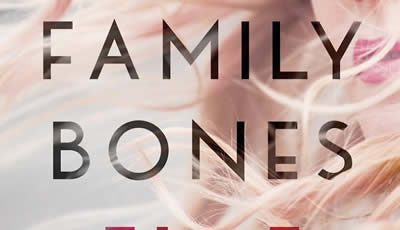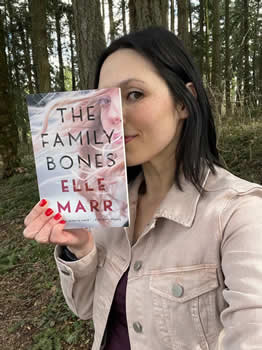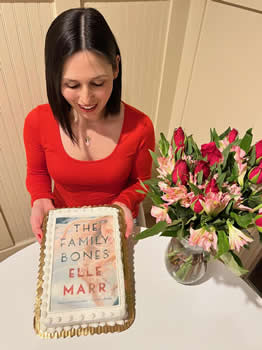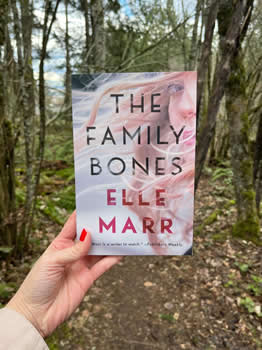

Features Up Close: Elle Marr
All in the Family
 By Dawn Ius
By Dawn Ius
Elle Marr’s latest thriller—THE FAMILY BONES—all comes down to psychopathy.
Marr says while researching her previous novels, she realized how little we know about the catalysts of psychopathy. For instance, evidence shows that the psychopathic trait can show up in families, and contrary to popular belief, treatment may not have rehabilitative outcomes.
“That information got me thinking: what if this trait did appear across multiple generations of the same family? What would that look like? How overt or subtle would the presence of that “quirk” affect everyone in that bloodline, and those who are, for our intents and purposes, neurotypical?” Marr says. “As soon as I landed on this idea, I wondered whether everyone would play nice at a family reunion.”
As you might expect, they all don’t. But in this twisty thriller packed with shocking reveals and a powerhouse of an ending, it’s likely all you’ll guess. The story takes place in a remote location with a large cast of…well, psychopaths.
In this interview with The Big Thrill, Marr shares insight into how she crafted the fabulous characters that make up this dysfunctional family, the fascinating things she learned during her research, and why diversity matters.
At the heart of this large cast of characters is Olivia Eriksen—an aspiring psychologist /grad student who is part of a family well known for its many sociopaths and psychopaths. I’d love to know more about her and how she took shape for you.
When I come across a crime, I often wonder how the family of the perpetrator is affected; Olivia is my exploration of those unintended victims. She grew up with the knowledge that several of her relatives committed crimes and were sent to prison for them, including her father—and several more have committed crimes yet never been caught. The stigma of being associated with her kin is so great that Olivia paradoxically leans into it, embracing her family’s infamy by taking to social media and building a brand around her personal experiences with psychopathy and sociopathy. In doing so, Olivia retakes control over the narrative that continues to shape her life from decades past. She demonstrates the grit it takes to make proverbial lemonade from long-soured fruit.
I’d also love to learn more about Birdie, the intrepid true crime podcaster who is trying to track down a missing person. I love her voice! With so many POV options, why did you land on her?
Birdie is a stay-at-home mom and true crime podcaster, and I tried to echo in her the modern podcasters who make real headway in shedding light on forgotten injustices. Michelle McNamara, author of I’ll Be Gone in the Dark, who revived interest in the Golden State Killer, and musician and podcaster Chris Lambert who recently helped to solve a cold case through his series Your Own Backyard, each inspired Birdie’s ingenuity and dedication. She is my “everyman” character, with a chip on her shoulder due to her own personal loss. A passionate advocate for victims that the media seems to have missed, Birdie only pauses her dogged pursuit of the truth every day to tuck her daughter into bed at night; she’s my reminder that, depending on the perspective, you can be either the villain or the hero of the story. In a cast of big and eye-catching personalities, it’s gratifying to learn that Birdie stood out for you!
THE FAMILY BONES is told in dual points of view and also includes newspaper clippings and journal entries—it’s a unique structure often hard to pull off, but you do it with ease. What’s the secret to nailing a dual timeline, particularly in light of the fact that you also have woven in different text elements?
A very detailed Excel spreadsheet, and long brainstorming sessions involving cookies are always helpful! I don’t know if there is a secret to it, but I do find it a fun exercise to weave in clues throughout each timeline to further bolster the other. It was my hope that the different text elements, while seemingly disparate, help to paint the overall world of this story.
One of the things that stood out while reading this book was the representation—how important is diversity in your writing and contributing to representation in novels?
Personally, I couldn’t write books without a diverse cast of characters; that’s not real life. In my writing, I strive to reflect the world around me, as well as infusing more of the world into my pages that I didn’t see in books while growing up. I consider it an immense privilege to write about Asian-American and mixed race characters, along with their friends, frenemies, and coworkers, who in turn add their own unique backgrounds to the plot. Because I am so passionate about representation, the acknowledgement and celebration of different cultural identities always seem to find their way into my stories.
This book really delves into the science behind sociopaths and psychopaths. I suspect this took an incredible amount of research. Was there anything surprising you learned in your research?
Absolutely. I learned how highly functioning in society that psychopaths and sociopaths can be. Although when I began writing THE FAMILY BONES, I was aware that these traits don’t appear as dramatically terrifying as movies make them out to be, I didn’t realize that many qualities of psychopathy which could be dangerous in interpersonal relationships can also make those individuals highly sought-after professionals. Qualities such as self-centeredness, being manipulative, and being single-minded about goals at the detriment of others often lead to empty emotional connections. Yet they also make for traditional leadership qualities in certain work environments. I had a lightbulb moment when I considered a few public figures who fit that bill.
THE FAMILY BONES is first and foremost a riveting thriller, but you have some underlying themes, such as “nature vs nurture” and some of the misconceptions around mental disorders, the effects of trauma and regret, etc. What do you hope readers take away from this story, aside from a satisfying read?
I hope the topics of therapy and mental health are somewhat destigmatized, if only in a small way. I hope that readers come away from its pages with more awareness around the broad spectrum of cognitive disorders, and with a little more comfort discussing mental and emotional health in general. That not all stigmatized conditions or disorders appear as they are portrayed in the media. Several of my books touch on mental health and its importance, but THE FAMILY BONES is probably my (covert) love letter to neurodivergence.
Your descriptions of the remote mountain resort where the family reunion takes place are stunning. What can you tell us about the inspiration for the setting in THE FAMILY BONES?
I knew I wanted a secluded mountain location in the Pacific Northwest for the Eriksen family reunion. When I opened a map and began researching possible wooded areas, my eyes landed on the name “Malheur National Forest.” I speak French and knew that “malheur” can mean “misfortune” or “bad luck”. Before I clicked on a website for this national preserve, I knew then I had found my unfortunate setting.
We’d love to hear about what you’re working on next!
My next thriller THE ALONE TIME is set to publish in March 2024. It’s a cross between Showtime’s Yellowjackets and Karin Slaughter’s Pretty Girls, and I can’t wait for readers to go on this journey. Thank you for the chance to talk writing with The Big Thrill!
- On the Cover: Alisa Lynn Valdés - March 31, 2023
- On the Cover: Melissa Cassera - March 31, 2023
- Behind the Scenes: From Book to Netflix - March 31, 2023




